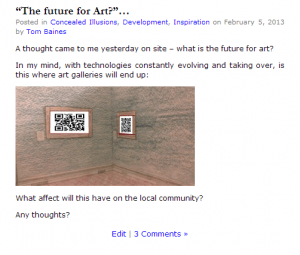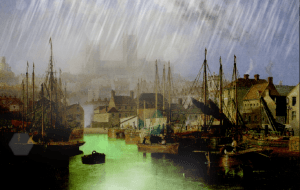On the 4th May 2013, at 1pm, ‘The Collection of Concealed Illusions’ was unveiled to the public within the Usher gallery. So now that performance is over it is time for reflection, on how it went and tie up any lose ends and ideas.
The performance started with the projection of the ‘Brayford pool and cathedral’ painting, which transformed over the course of a 20 minute loop between this and the digitalised one that I created, which showed the same image only not as aesthetically pleasing. The reason for this was, when the original painting was on the wall in the gallery the small piece of text next to it had said that the painting was ‘idealised’. So as I have said before no swans, no fisherman and no artistic mist. This was the base for our performance. Therefore we intended to reveal to the public, that many paintings are idealised.
From this we looked at the modern equivalent of idealisation. ‘Instagram’ a modern iPhone ‘app’ has to ability to add a ‘filter’ to a picture which will leave it blemish free – if you like, a modern idealisation. We then decided to take a picture of the present day Brayford and apply every filter in instagram to it and use them as a link between the video and the rest of the performance, I shall return to this link later. Then of course, the painting of the Brayford was removed and replaced by a local artist’s depiction of the ‘Venus de Milo’ drawn on paper by pencil. At this point we were lost but made this negative into a positive.
To our amazement the artist was born around the same time as the painting of the Brayford was done and the ‘Venus de Milo’ drawings were pencil on paper – exactly what I was doing in the performance. To link this in further and without completely scrapping the video and the other instagram images we had printed we decided to instagram a picture of the Venus de Milo and apply every filter and interspersed them amongst the Brayford pictures that would be on the floor.
Now to the live aspect of the performance. The girls in the group were applying and removing layers of make up for the duration of our piece – a live representation of idealised paintings.; and of course the similarity between make up application and painting. Here I should return to the link stated earlier. With the video and the photos on the floor it is showing a visual representation of idealised images both modern and past and how idealisation or if you like masking or hiding a ‘true identity’ is still around. I would also seem ridiculous to leave out the fact that this is a gallery. So by having me draw the girls, it is exhibiting the live art similarly to the paintings being exhibited around the gallery. I am making copies of beauty, just like the local Lincolnshire artist is making copies of the statue of Aphrodite the ancient Greek goddess of love and beauty – the Venus de Milo.
Another small theme from our piece is society’s view on idealisation or rather men’s view. I am a male, drawing females. Here there is a sense of men’s view on women when they go out and of course the patriarchal society. But also, with no thought of better word, women exploiting their role to get men to do what they want. In our performance when the girls got up to take off their make-up in front of the projection and the Venus de Milo I turned and watch and continued to draw.
A late addition to the piece was the addition of sound which consisted of the girls speaking ‘make-up’ tips which would play on loop throughout and was interspersed with tips on painting. Again this was to reinforce the similarities between the application of paint and make-up.
Finally I believe our performance went well and reinforced our key theme of idealisation. Having spoken to some people after about it, it was clear some links they had figured out themselves and once told what the project was about was very clear to them and they understood more. On reflection I think next time if this piece was to go on or just to develop it further I would like to think about ways in which the performance could reinforce our theme more clearly, however the element of uncertainty made the audience think about the performance more. Next time I would like to experiment the way we could have used the whole Usher gallery and maybe even the grounds.


